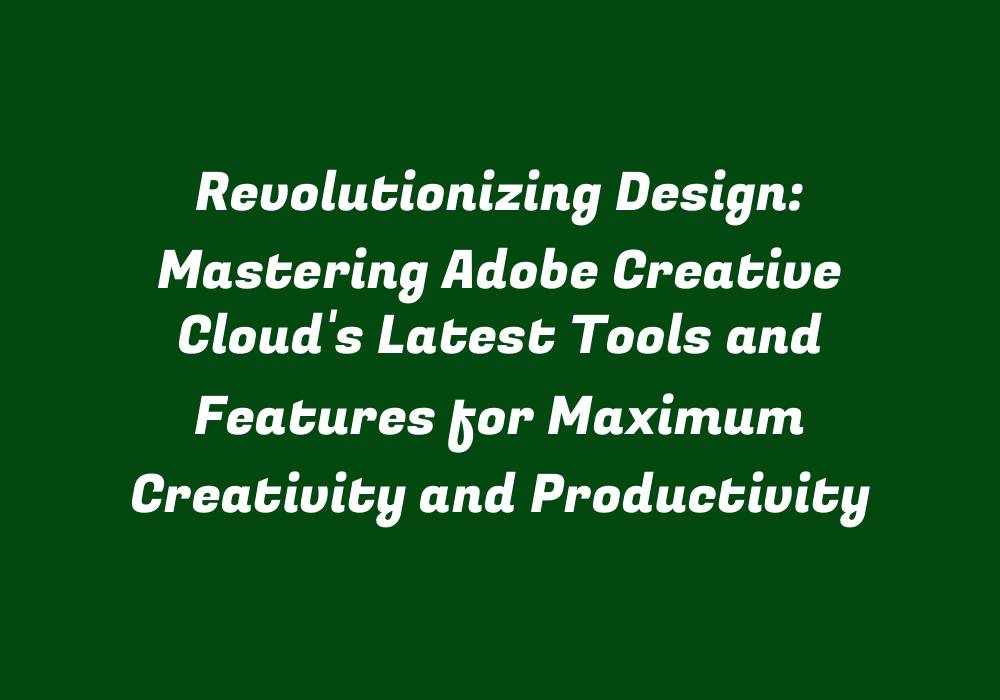Introduction
The creative industry is constantly evolving, demanding innovative tools and techniques to keep up with the ever-changing market trends. Adobe Creative Cloud has emerged as a crucial platform for creatives in this digital era, providing a comprehensive suite of applications that empower professionals to excel in various fields such as graphic design, web development, video production, photography, and so on. This article explores the latest tools and features introduced by Adobe Creative Cloud, emphasizing their potential impact on revolutionizing design for maximum creativity and productivity.
Adobe Photoshop: The Ultimate Image Editing Toolkit
Photoshop is undoubtedly one of the most well-known applications within the Adobe Creative Suite, with its countless features that empower designers to edit and manipulate images seamlessly. In recent updates, Adobe has introduced new tools such as the Content-Aware Fill, which allows for automatic adjustments to image details based on surrounding content. This feature significantly streamlines the editing process, especially when dealing with complex compositions or removing unwanted elements from photos.
Another notable update is the enhanced selection tool, which now includes an advanced Select Subject option that can intelligently isolate specific subjects in images. This makes it easier to focus on a particular object while removing background distractions. Additionally, the Object Selection feature simplifies the task of separating multiple objects from their backgrounds.
Adobe Illustrator: The Artistry of Vector Graphics
Illustrator is a powerhouse for creating and editing vector graphics, allowing designers to produce crisp, scalable illustrations with minimal loss in quality. Recent advancements in Adobe Illustrator include a new Pixel Preview mode that displays artwork as if it were rendered from pixels, rather than the usual vector-based rendering. This is particularly useful when working on projects where a more realistic appearance or blending of styles is desired.
Furthermore, Illustrator has introduced a new Live Shape feature, which makes it easier to resize and adjust the shapes while maintaining their aspect ratio. This tool enables designers to create complex geometric shapes and patterns with precision, making it an indispensable asset in various design projects, such as logo creation or web page layouts.
Adobe InDesign: The Art of Typography and Page Layout
InDesign has long been a preferred choice for those seeking professional-level page layouts. Its most recent updates include enhancements to text formatting, making it easier for designers to create beautiful typographic designs by adjusting font size, line height, character spacing, and more, all in one place. Additionally, InDesign now supports more advanced grid systems, which allow for greater control over the arrangement of content on a page.
Furthermore, with new updates to its export features, designers can easily create interactive PDFs that enable readers to navigate through pages without having access to the full InDesign application. This streamlines collaboration between designers and clients or coworkers who may not be familiar with Adobe products.
Adobe After Effects: The Art of Motion Graphics and Video Editing
After Effects is a powerful tool for creating motion graphics, visual effects, and video compositions. Its latest updates introduce features like the Warp Stabilizer VFX, which can significantly reduce camera shake in footage and make it easier to integrate various elements into seamless scenes.
Additionally, After Effects now offers enhanced integration with other Adobe applications, making it possible for creators to easily transfer assets between different platforms. For instance, designers using Photoshop can directly import their artwork into After Effects and incorporate them into their motion graphics projects, streamlining the workflow and saving valuable time.
Adobe XD: The Art of User Experience Design
With the increasing demand for user-friendly websites and applications, Adobe XD has emerged as a crucial tool for designing digital products that offer smooth, intuitive experiences. Its most recent updates include the ability to create responsive designs that adapt seamlessly to different screen sizes, ensuring optimal user experiences across various devices. Furthermore, designers can now collaborate more efficiently with their team using XD’s cloud-based sharing and commenting features.
Adobe Stock: The Art of Finding Inspiration
Adobe Stock is a unique platform that offers over 100 million high-quality assets to fuel creativity within the Adobe ecosystem. With new integration features, creatives can now browse for inspiration and incorporate stock images, videos, or illustrations directly into their projects without having to leave the applications. This streamlined workflow greatly improves efficiency and allows designers to focus on creating unique content rather than searching for relevant assets.
Conclusion
Adobe Creative Cloud’s latest tools and features serve as powerful catalysts in revolutionizing design, enabling creatives to push the boundaries of their craft while improving productivity and collaboration. By mastering these applications and continuously exploring new functionalities, designers can unlock a world of possibilities, ultimately driving innovation in various industries and delivering exceptional experiences for consumers. As technology continues to evolve at an unprecedented pace, the creative community must adapt to keep abreast with cutting-edge design techniques and practices.
